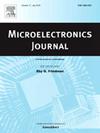The sampling network for a 16-channel time-interleaved ADC
IF 1.9
3区 工程技术
Q3 ENGINEERING, ELECTRICAL & ELECTRONIC
引用次数: 0
Abstract
This paper presents the design of a sampling network for an 8-bit, 16 GS/s, 16-channel time-interleaved analog-to-digital converter (ADC) implemented in a 28 nm CMOS process. The network is based on a two-stage resampling architecture. A current-feedback source follower is employed as the buffer, improving the speed and linearity of the buffering stages. Additionally, a novel parallel-path bootstrapped switch is introduced, which significantly enhances the sampling speed. The design also incorporates 4-phase, 4 GHz clocks for the first-stage switches and 16-phase, 1 GHz clocks for the second-stage switches. The entire sampling network occupies an area of 0.2 mm2 and consumes a total power of 63.95 mW. Post-simulation results demonstrate that the sampling network achieves a bandwidth exceeding 9 GHz, with a signal-to-noise plus distortion ratio (SNDR) of 57.6 dB and a spurious-free dynamic range (SFDR) of 62.1 dB at the Nyquist input frequency.
求助全文
约1分钟内获得全文
求助全文
来源期刊

Microelectronics Journal
工程技术-工程:电子与电气
CiteScore
4.00
自引率
27.30%
发文量
222
审稿时长
43 days
期刊介绍:
Published since 1969, the Microelectronics Journal is an international forum for the dissemination of research and applications of microelectronic systems, circuits, and emerging technologies. Papers published in the Microelectronics Journal have undergone peer review to ensure originality, relevance, and timeliness. The journal thus provides a worldwide, regular, and comprehensive update on microelectronic circuits and systems.
The Microelectronics Journal invites papers describing significant research and applications in all of the areas listed below. Comprehensive review/survey papers covering recent developments will also be considered. The Microelectronics Journal covers circuits and systems. This topic includes but is not limited to: Analog, digital, mixed, and RF circuits and related design methodologies; Logic, architectural, and system level synthesis; Testing, design for testability, built-in self-test; Area, power, and thermal analysis and design; Mixed-domain simulation and design; Embedded systems; Non-von Neumann computing and related technologies and circuits; Design and test of high complexity systems integration; SoC, NoC, SIP, and NIP design and test; 3-D integration design and analysis; Emerging device technologies and circuits, such as FinFETs, SETs, spintronics, SFQ, MTJ, etc.
Application aspects such as signal and image processing including circuits for cryptography, sensors, and actuators including sensor networks, reliability and quality issues, and economic models are also welcome.
 求助内容:
求助内容: 应助结果提醒方式:
应助结果提醒方式:


